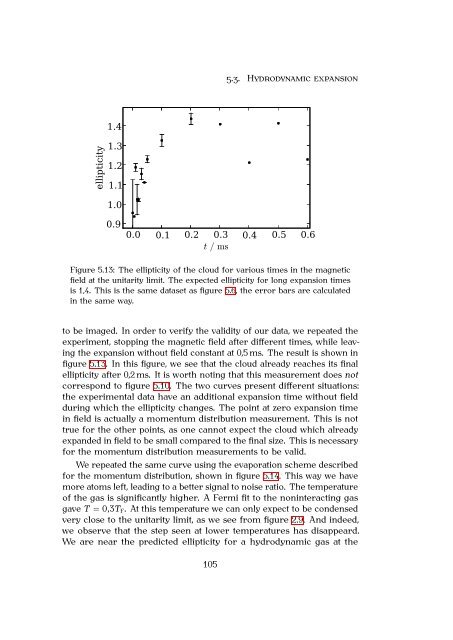Martin Teichmann Atomes de lithium-6 ultra froids dans la ... - TEL
Martin Teichmann Atomes de lithium-6 ultra froids dans la ... - TEL
Martin Teichmann Atomes de lithium-6 ultra froids dans la ... - TEL
You also want an ePaper? Increase the reach of your titles
YUMPU automatically turns print PDFs into web optimized ePapers that Google loves.
ellipticity<br />
1.4<br />
1.3<br />
1.2<br />
1.1<br />
1.0<br />
0.9<br />
5.3. HYDRODYNAMIC EXPANSION<br />
0.0 0.1 0.2 0.3<br />
t = ms<br />
0.4 0.5 0.6<br />
Figure 5.13: The ellipticity of the cloud for various times in the magnetic<br />
field at the unitarity limit. The expected ellipticity for long expansion times<br />
is 1,4. This is the same dataset as figure 5.6, the error bars are calcu<strong>la</strong>ted<br />
in the same way.<br />
to be imaged. In or<strong>de</strong>r to verify the validity of our data, we repeated the<br />
experiment, stopping the magnetic field after different times, while leaving<br />
the expansion without field constant at 0,5 ms. The result is shown in<br />
figure 5.13. In this figure, we see that the cloud already reaches its final<br />
ellipticity after 0,2 ms. It is worth noting that this measurement does not<br />
correspond to figure 5.10. The two curves present different situations:<br />
the experimental data have an additional expansion time without field<br />
during which the ellipticity changes. The point at zero expansion time<br />
in field is actually a momentum distribution measurement. This is not<br />
true for the other points, as one cannot expect the cloud which already<br />
expan<strong>de</strong>d in field to be small compared to the final size. This is necessary<br />
for the momentum distribution measurements to be valid.<br />
We repeated the same curve using the evaporation scheme <strong>de</strong>scribed<br />
for the momentum distribution, shown in figure 5.14. This way we have<br />
more atoms left, leading to a better signal to noise ratio. The temperature<br />
of the gas is significantly higher. A Fermi fit to the noninteracting gas<br />
gave T = 0,3TF. At this temperature we can only expect to be con<strong>de</strong>nsed<br />
very close to the unitarity limit, as we see from figure 2.9. And in<strong>de</strong>ed,<br />
we observe that the step seen at lower temperatures has disappeard.<br />
We are near the predicted ellipticity for a hydrodynamic gas at the<br />
105

















